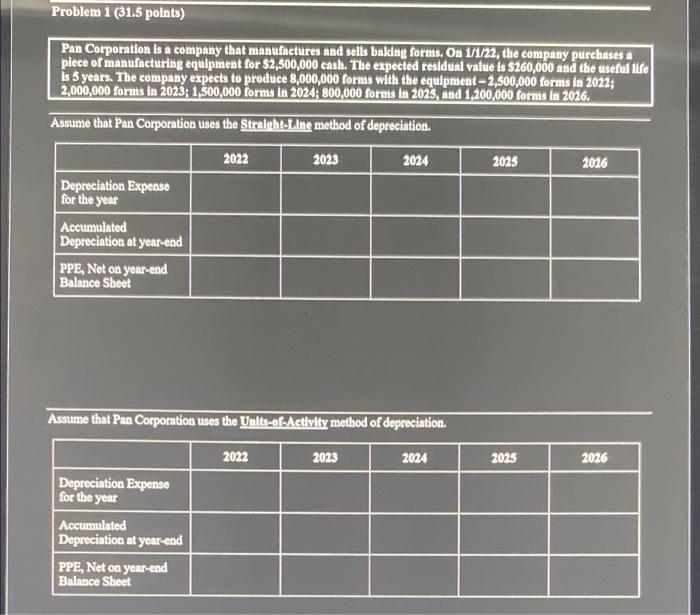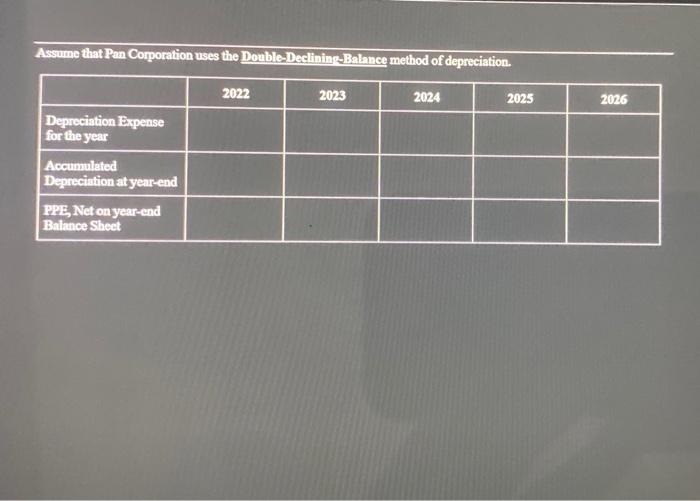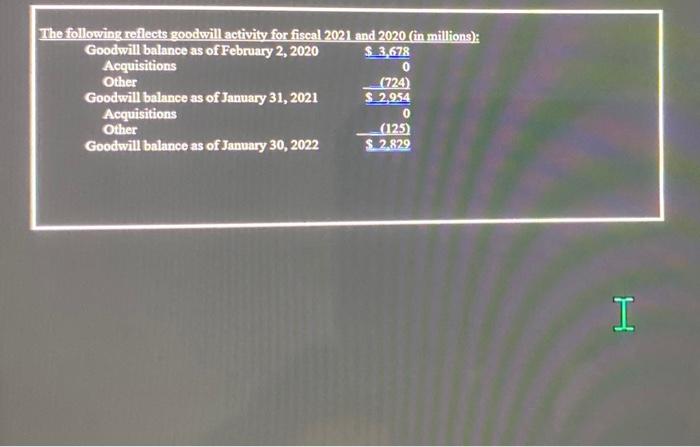Answered step by step
Verified Expert Solution
Question
1 Approved Answer
need help asap Problem 1 (31.5 points) Pan Corporation is a company that manufactures and sells baking forms. On 1/1/22, the company purchases a piece
need help asap 




Problem 1 (31.5 points) Pan Corporation is a company that manufactures and sells baking forms. On 1/1/22, the company purchases a piece of manufacturing equipment for $2,500,000 cash. The expected residual value is $260,000 and the useful life is 5 years. The company expects to produce 8,000,000 forms with the equipment-2,500,000 forms in 2022; 2,000,000 forms in 2023; 1,500,000 forms in 2024; 800,000 forms in 2025, and 1,200,000 forms in 2026. Assume that Pan Corporation uses the Straight-Line method of depreciation. 2022 2023 2024 2025 2026 Depreciation Expense for the year Accumulated Depreciation at year-end PPE, Net on year-end Balance Sheet Assume that Pan Corporation uses the Units-of-Activity method of depreciation. 2022 2023 2024 Depreciation Expense for the year Accumulated Depreciation at year-end PPE, Net on year-end Balance Sheet 2025 2026 Assume that Pan Corporation uses the Double-Declining-Balance method of depreciation. 2022 2023 2024 2025 Depreciation Expense for the year Accumulated Depreciation at year-end PPE, Net on year-end Balance Sheet 2026 PVH Consolidated Balance Sheets In millions of dollars ASSETS Cash and cash equivalents Accounts receivable, net of the allowance of $62 million as of 1/30/2022 and of $70 million as of 1/31/2021 Inventories Prepaid expenses and other current assets Total current assets Property, plant, and equipment, net Goodwill Tradenames Other intangibles, net Other long-term assets Total assets LIABILITIES AND STOCKHOLDERS' EQUITY Account payable Accrued expenses Unearned revenue Short-term borrowings and other current liabilities Total current liabilities Long-term debt Other long-term liabilities Total liabilities Common stock Retained earnings Total stockholders' equity Total liabilities and stockholders' equity As of Jan. 30, 2022 $ 1,243 745 1,349 317 $ 3,654 906 2,829 2,723 584 1,701 $ 12,397 $1,221 1,101 45 421 2,788 2,318 2,003 7,109 3,285 2,003 5,288 $ 12,397 As of Jan. 31, 2021 $ 1,651 642 1,417 234 $ 3,944 943 2,954 2,870 648 1,935 $ 13,294 $ 1,124 940 56 462 2,582 3,514 2,467 8,563 3,216 1,515 4,731 $ 13,294 I Notes to Consolidated Financial Statements (partial) 1.1. Description of Business PVH Corp. constitute a global apparel company with a brand portfolio that includes TOMMY HILFIGER, Calvin Klein, Warner's, Olga, and Trued Co., which are owned, Van Heusen, IZOD, ARROW, and Geoffrey Beene, which the Company owned through the second quarter of 2021 and now licenses back for certain product categories, and other licensed brands. The Company designs and markets branded sportswear (casual apparel), jeanswear, performance apparel, intimate apparel, underwear, swimwear, dress shirts, neckwear, handbags, accessories, footwear and other related products and licenses its owned brands globally over a broad array of product categories and for use in numerous discrete jurisdictions. 1.3. Fiscal Year The Company uses a 52-53 week fiscal year ending on the Sunday closest to February 1. Results for fiscal years 2021, 2020 and 2019 represent the 52 weeks ended January 30, 2022, January 31, 2021 and February 2, 2020, respectively. 1.11. Property and Equipment Property and equipment consisted of the following (in millions): As of 1/30/2022 1/31/2021 Land $1 $1 31 55 Buildings and building improvements Machinery, software and equipment Furniture and fixtures 982 926 549 580 227 246 Shop-in-shops/concession locations Leasehold improvements Construction-in-progress 765 835 97 52 2,652 2,695 Total property and equipment Accumulated depreciation (1,746) (1,752) $ 943 Property and equipment, net $ 906 Property, plant and equipment is stated at cost less accumulated depreciation. Depreciation is generally provided over the estimated useful lives of the related assets on a straight-line basis. The range of useful lives is as follows: Buildings and building improvements-15 to 40 years; machinery, software and equipment-2 to 10 years; furniture and fixtures-2 to 10 years; and fixtures located in shop-in-shop/concession locations and their related costs-3 to 4 years. Leasehold improvements are depreciated using the straight-line method over the lesser of the term of the related lease or the estimated useful life of the asset. Depreciation expense totaled $267 million and $281 million in fiscal years 2021 and 2020, respectively. 7. Goodwill and Other Intangible Assets Goodwill and indefinite-lived intangible assets not subject to amortization are tested for impairment annually, at the beginning of the third quarter of each fiscal year, and between annual tests if an event occurs or circumstances change that would indicate that it is more likely than not that the carrying amount may be impaired. There was no impairment of goodwill in fiscal year 2021 but some goodwill impairment was recorded for fiscal year 2020. Purchased intangible assets with finite lives are amortized over their estimated useful lives using the straight- line and are tested for impairment. Amortization expense related to the Company's intangible assets subject to amortization was $34 million and $34 million for fiscal year 2021 and 2020, respectively. The following reflects goodwill activity for fiscal 2021 and 2020 (in millions): $ 3,678 Goodwill balance as of February 2, 2020 Acquisitions 0 Other (724) Goodwill balance as of January 31, 2021 $ 2,954 Acquisitions 0 Other (125) $2.829 Goodwill balance as of January 30, 2022 




Step by Step Solution
There are 3 Steps involved in it
Step: 1

Get Instant Access to Expert-Tailored Solutions
See step-by-step solutions with expert insights and AI powered tools for academic success
Step: 2

Step: 3

Ace Your Homework with AI
Get the answers you need in no time with our AI-driven, step-by-step assistance
Get Started


